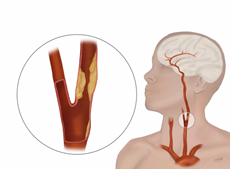New Procedure Offered for Carotid Artery Disease
 Carotid artery disease (CAD) is one of the leading causes of stroke. CAD is a serious condition caused by atherosclerosis – a buildup of plaque comprised of fat, cholesterol, calcium, and other substances in the blood. The carotid arteries are major blood vessels on either side of the neck that supply blood to the brain. CAD occurs when plaque narrows or blocks these blood vessels. Plaque platelets may dislodge, or plaque may cause clotting, both of which may cause stroke.
Carotid artery disease (CAD) is one of the leading causes of stroke. CAD is a serious condition caused by atherosclerosis – a buildup of plaque comprised of fat, cholesterol, calcium, and other substances in the blood. The carotid arteries are major blood vessels on either side of the neck that supply blood to the brain. CAD occurs when plaque narrows or blocks these blood vessels. Plaque platelets may dislodge, or plaque may cause clotting, both of which may cause stroke.
As a specialty, vascular surgery utilizes minimally invasive techniques or open surgical intervention to treat a wide variety of blood vessel problems, including CAD. A traditional surgical procedure for CAD, called a carotid endarterectomy, removes plaque from the carotid artery. However, this surgery is invasive and may not be the best option based on anatomical challenges or plaque location. Licking Memorial Vascular Surgery recently added an alternative procedure called transcarotid artery revascularization (TCAR) for patients with CAD who have a higher risk of complications from surgery due to age or other health issues.
TCAR is a clinically proven, minimally invasive procedure used to treat CAD and help prevent future strokes. It provides direct access to the artery and temporarily reverses blood flow so that any bits of plaque that may break off are diverted away from the brain. TCAR takes less time than traditional surgery, limiting stress on the heart and minimizing the risk of perioperative or pre-perioperative complications.
“We are so pleased to have Mark DeFrancisco, D.O., William Phillips, D.O., and Howard Reeves, D.O., at Licking Memorial Vascular Surgery. They are highly skilled vascular surgeons who can provide a wide variety of treatments for patients with CAD and other vascular conditions,” said Licking Memorial Health Systems President & CEO Rob Montagnese. “Offering the TCAR procedure to our patients allows LMHS to provide quality healthcare close to home and further our mission to improve the health of the community.”
The procedure begins with a small incision made just above the collarbone to allow access to the carotid artery. A specialized sheath is placed through a small puncture in the carotid artery. To protect the brain from debris during the procedure, blood flow is directed away from the brain using a mechanical pump. The blood passes through an external filter and back into a vein in the leg. The reverse flow allows the surgeon to place a stent into the carotid artery to stabilize the plaque and help prevent future strokes. Once the carotid stent is in place, flow reversal is turned off and blood flow resumes in its normal direction.
Patients who undergo a TCAR procedure will have an overnight stay at the Hospital, but tend to recover quickly. Post-surgical instructions are given, which include refraining from strenuous activities and heavy lifting for at least a week. A blood-thinning medication will be prescribed to prevent blood clots from forming in the newly opened artery. An ultrasound will be performed during a follow-up visit to evaluate the treated artery.
| Posted On : 5/23/2023 9:22:53 AM